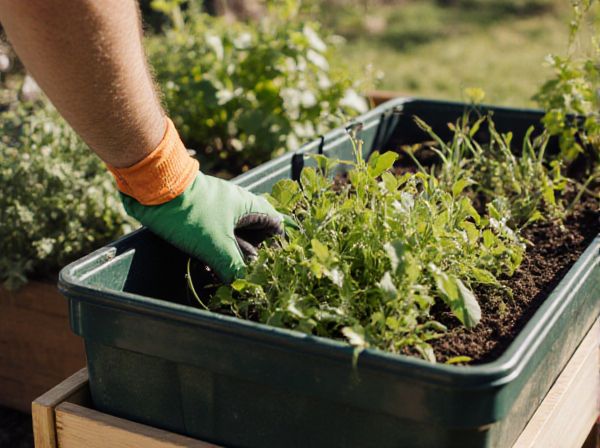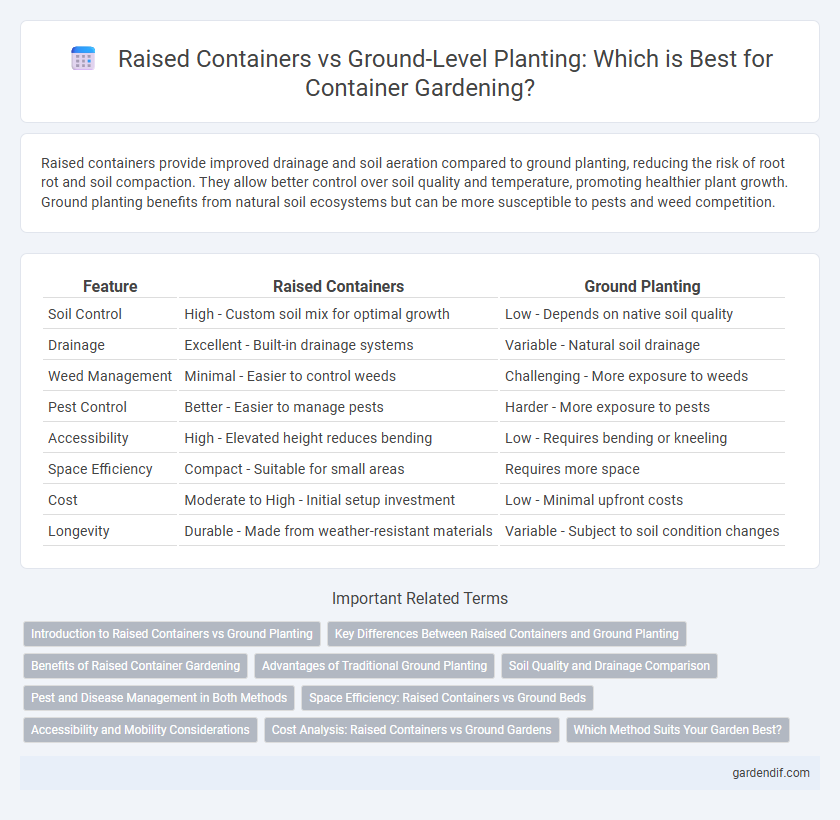
Raised containers vs ground planting Illustration
Raised containers provide improved drainage and soil aeration compared to ground planting, reducing the risk of root rot and soil compaction. They allow better control over soil quality and temperature, promoting healthier plant growth. Ground planting benefits from natural soil ecosystems but can be more susceptible to pests and weed competition.
Table of Comparison
| Feature | Raised Containers | Ground Planting |
|---|---|---|
| Soil Control | High - Custom soil mix for optimal growth | Low - Depends on native soil quality |
| Drainage | Excellent - Built-in drainage systems | Variable - Natural soil drainage |
| Weed Management | Minimal - Easier to control weeds | Challenging - More exposure to weeds |
| Pest Control | Better - Easier to manage pests | Harder - More exposure to pests |
| Accessibility | High - Elevated height reduces bending | Low - Requires bending or kneeling |
| Space Efficiency | Compact - Suitable for small areas | Requires more space |
| Cost | Moderate to High - Initial setup investment | Low - Minimal upfront costs |
| Longevity | Durable - Made from weather-resistant materials | Variable - Subject to soil condition changes |
Introduction to Raised Containers vs Ground Planting
Raised containers offer improved soil drainage and control over soil composition, enhancing root health and plant growth compared to traditional ground planting. They reduce soil compaction and weed competition while allowing for easier access and maintenance, making them ideal for urban gardening and areas with poor soil quality. Ground planting relies on existing soil conditions and requires more effort to amend soil for optimal plant development.
Key Differences Between Raised Containers and Ground Planting
Raised containers offer improved soil drainage and controlled growing conditions compared to ground planting, which can suffer from soil compaction and variable nutrient levels. Root development in raised containers is often more robust due to better aeration and reduced competition from weeds and pests. Ground planting allows for larger root expansion and can support bigger plants but requires careful soil management to prevent issues like poor drainage and nutrient depletion.
Benefits of Raised Container Gardening
Raised container gardening improves soil drainage and aeration, reducing the risk of root rot and promoting healthier plant growth. It allows for precise control over soil quality and nutrient levels, optimizing conditions for various crops. Elevated containers also minimize weed intrusion and pests, enhancing overall garden productivity and maintenance efficiency.
Advantages of Traditional Ground Planting
Traditional ground planting allows plants to access a natural soil ecosystem, promoting beneficial microbial activity and deeper root growth for healthier development. It provides better water retention and drainage balance, reducing the risk of overwatering or drying out compared to raised containers. The ground environment typically supports larger plant size and yields due to unrestricted root expansion and nutrient availability.
Soil Quality and Drainage Comparison
Raised containers offer superior soil quality control by allowing gardeners to customize soil composition, minimizing compaction and enhancing nutrient availability compared to ground planting. They also provide improved drainage, preventing waterlogging and root rot due to elevated positioning and tailored soil mixes with optimal porosity. In contrast, ground planting often faces challenges with native soil variability and poor drainage, which can lead to stagnant water and reduced oxygen for roots.
Pest and Disease Management in Both Methods
Raised containers offer improved pest and disease management by providing better drainage and airflow, reducing the risk of root rot and fungal infections often encountered in ground planting. Soil in raised containers can be sterilized or replaced more easily, limiting exposure to soil-borne pests and pathogens prevalent in traditional ground planting. Ground planting, however, may require more frequent monitoring and organic or chemical treatments due to direct contact with native soil and environmental pest pressures.
Space Efficiency: Raised Containers vs Ground Beds
Raised containers maximize space efficiency by allowing vertical stacking and placement in small, unused areas, unlike ground beds which require horizontal space and often limit gardening to soil accessibility. The controlled environment of raised containers enables intensive planting and higher yield per square foot, optimizing limited urban or patio spaces. Ground beds, while beneficial for root expansion, generally consume more land area and are less flexible in tight or unconventional locations.
Accessibility and Mobility Considerations
Raised containers improve accessibility by reducing the need to bend or kneel, making gardening easier for individuals with limited mobility or physical disabilities. These containers can be placed on tables or stands, allowing for comfortable wheelchair access and better ergonomic positioning. In contrast, ground planting often requires more physical effort to reach and maintain, which can limit gardening opportunities for those with mobility challenges.
Cost Analysis: Raised Containers vs Ground Gardens
Raised containers typically involve higher initial costs due to materials like wood, metal, or plastic, but offer long-term savings by improving soil control and reducing weed management expenses. Ground gardens require less upfront investment, relying on natural soil, but may incur ongoing costs related to soil amendments, pest control, and irrigation. Economically, raised containers provide cost efficiency through enhanced crop yields and reduced maintenance, balancing the initial expense with sustainable gardening benefits.
Which Method Suits Your Garden Best?
Raised containers offer superior soil drainage and temperature control, making them ideal for gardens with poor or compacted soil conditions. Ground planting enables deeper root growth and better access to natural soil nutrients, benefiting plants that require extensive root systems. Choosing the best method depends on your garden's soil quality, plant species, and space availability, with raised beds favored for urban or small spaces and ground planting preferred for open, fertile areas.
Raised containers vs ground planting Infographic

 gardendif.com
gardendif.com